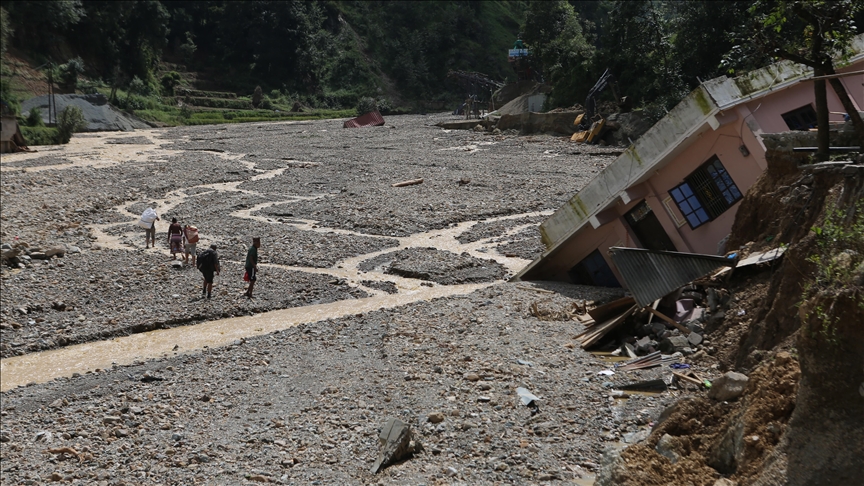‚ÄòOur snow is melting‚Ä�: Nepal battles fallout of global climate inaction
The Himalayan nation is grappling with melting glaciers, erratic weather patterns, and growing climate-induced disasters, including heavy rainfall, floods, and landslides
 People walk along the damaged house swept by the flood caused by the heavy rain at the bank of Nakhu river in Tika Bhairav, Lalitpur Southern part of Kathmandu, Nepal
People walk along the damaged house swept by the flood caused by the heavy rain at the bank of Nakhu river in Tika Bhairav, Lalitpur Southern part of Kathmandu, Nepal
- The Himalayan nation is grappling with melting glaciers, erratic weather patterns, and growing climate-induced disasters, including heavy rainfall, floods, and landslides
- Nepal’s reliance on a rain-fed agriculture system makes it particularly vulnerable to erratic rainfall and extreme weather, says Prajal Pradhan, an expert in food systems and climate change
- ‘We have a climate crisis here in Nepal. Our snow is melting, we are facing deforestation, and countries like the US are telling us that climate change is not real,’ says climate activist Milan Sharma Pudasaini
ISTANBUL
Despite contributing minimally to global greenhouse gas emissions, Nepal stands among the countries most severely impacted by climate change.
The Himalayan nation is grappling with melting glaciers, erratic weather patterns, and growing climate-induced disasters, particularly floods, landslides, heavy rainfall, lightning strikes, and fires.
From mid-2018 to mid-2024, there were 32,375 small and large-scale disaster incidents in Nepal, with climate-related occurrences accounting for 91.2% of them, according to a report released last year by the Home Affairs Ministry.
These incidents claimed 3,672 lives, with 446 more people missing and an additional 11,752 injured. More than 57,200 houses were impacted and over 43,100 infrastructure elements destroyed, data from the 2024 Nepal Disaster Report shows.
A 2024 paper by researchers from Nepal and several other countries documented the effects of rapid urbanization and deforestation – from 1990 to 2020, built-up areas expanded by 386% and the Kathmandu Valley lost 28% of its forest cover between 1989 and 2019.
The rapid melting of Himalayan glaciers has exacerbated these challenges, heightening the risk of glacial lake outburst floods (GLOFs) and avalanches, while threatening water availability for nearly 2 billion people across South Asia who rely on the region’s rivers.
According to Nepal’s National Adaptation Plan (NAP) 2021–2050, over 80% of property losses from disasters stem from floods, landslides, and GLOFs.
Nepal’s reliance on hydropower as its primary energy source further complicates the picture, as changes in glacier-fed water flow threaten energy security.
Another major concern for Nepal is its reliance on a rain-fed agriculture system that makes it particularly vulnerable to erratic rainfall and extreme weather, according to Prajal Pradhan, an expert in food systems and climate change.
“Increasing flooding is definitely an issue … Not having rainfall or enough rainfall when it is needed, and having more than needed when we don’t is also an issue,” he said in an interview with Anadolu.
That has left Nepal in a position where it has a “huge productivity gap” in terms of agricultural production, he added.
Changing climate patterns are also affecting public health, with poor nutrition, exacerbated by low agricultural productivity and food insecurity, contributing to rising cases of obesity, hypertension, and diabetes, he said.
Pradhan called for increased public awareness around sustainable diets and better farming practices to address Nepal’s “triple burden of malnourishment” – a combination of undernutrition, micronutrient deficiency, and overnutrition.
If the situation does not change, he warned, “definitely there will be more people suffering.”
Climate crisis in real time
Glacial melt and declining snow levels are another threat to Nepal.
The Hindu Kush Himalaya region, an 800-kilometer (nearly 500-mile) mountain chain considered a climate hotspot, has been experiencing reduced snow persistence, according to a 2024 report by the International Center for Integrated Mountain Development (ICIMOD).
This trend signals potential water shortages and reduced hydropower generation, which provides more than 90% of Nepal’s electricity.
“We have a climate crisis here in Nepal. Our snow is melting, we are facing deforestation, and countries like the US are telling us that climate change is not real,” said Milan Sharma Pudasaini, a climate activist and president of youth-led advocacy group CliMates Nepal.
“We are doing everything we can do, but we aren’t getting as much help from the world.”
He said climate-induced displacement is a growing phenomenon in the country, pushing people to either leave rural or low-income areas for urban regions, or to move abroad, view echoed by Pradhan.
Pudasaini emphasized that even Nepal’s biodiversity is changing, as snow leopards normally found in high-altitude terrain have been spotted in lower regions in recent years, an indicator of how rising temperatures are affecting wildlife.
No room for ‘business as usual’
In terms of efforts to address climate threats, both experts stressed the need for more systemic and long-term solutions.
Pradhan, an assistant professor at the University of Groningen in the Netherlands, suggested that Nepal must prioritize irrigation expansion, ensure the availability of fertilizers, and promote mechanization in agriculture.
“Combining practices of agroecology, regenerative agriculture, climate-smart agriculture, or sustainable intensifications … can bring up (agricultural) productivity,” he said.
He also emphasized the importance of reducing methane emissions from rice cultivation and improving soil health through sustainable farming methods.
Pudasaini, meanwhile, reiterated the need for global solidarity.
He said the country is lobbying for continued international climate funding based on its geographic vulnerability, and argued that Nepal should be compensated fairly for its efforts to conserve biodiversity and uphold international climate agreements.
Both experts also agreed that more robust governance is needed, with Pradhan pointing to implementation gaps in existing policies, while Pudasaini called for “ironclad, fast changes in rules.”
In Nepal’s case, said Pradhan, “it is not only about developing the right policy – it’s more about implementing the policies.”
“If you have the right policy and right interventions, things could be changed, but if we continue with business as usual, then there will be a problem.”
Anadolu Agency website contains only a portion of the news stories offered to subscribers in the AA News Broadcasting System (HAS), and in summarized form. Please contact us for subscription options.






